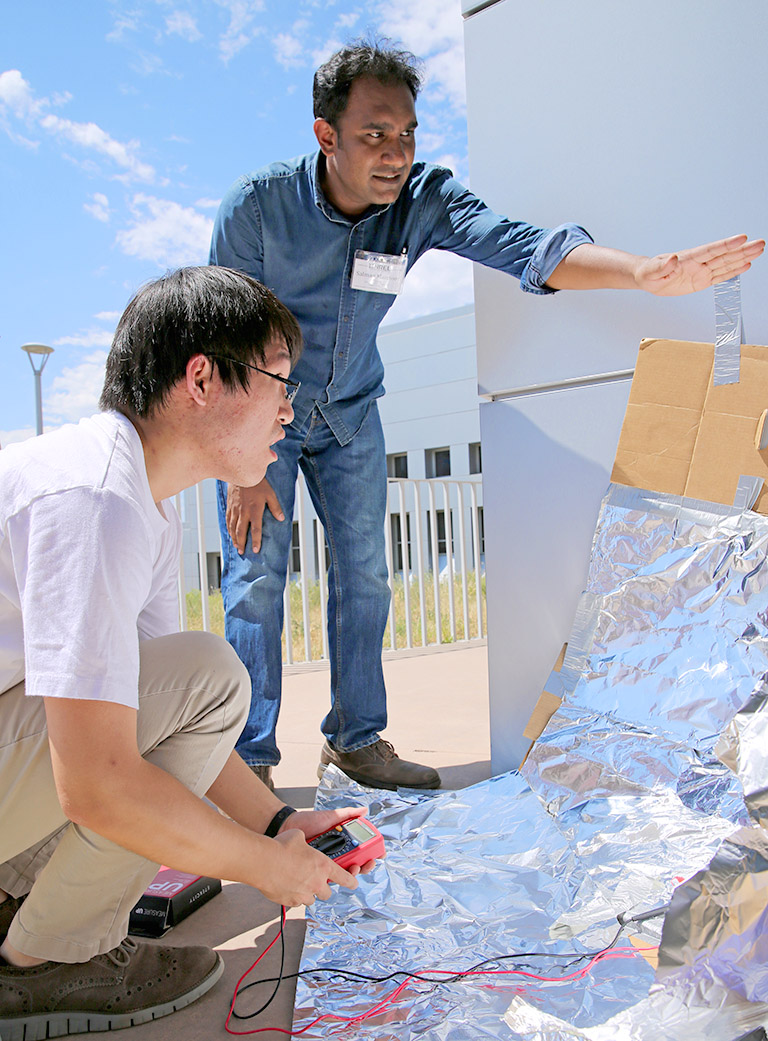Graduate Students Gain Hands-On PV Experience from NREL Researchers

Two students consider methods for concentrating sunlight on solar cells as part of an introductory exercise at the 2017 HOPE workshop.
Thirteen graduate students got a once-in-a-lifetime opportunity during the 2017 Hands-On PV Experience (HOPE) Workshop, learning from top solar scientists at the U.S. Department of Energy’s National Renewable Energy Laboratory (NREL).
HOPE gives students the chance to spend one week at NREL and deepen their knowledge of photovoltaics (PV). Started in 2012, the HOPE Workshop, hosted each year on NREL’s campus in Golden, Colorado, is designed to strengthen PV research at American universities, while fostering collaboration between the National Center for Photovoltaics (NCPV) and university PV researchers. This year, the workshop was held from July 23–29 and featured graduate students working on photovoltaic research at eight universities.
Students from the following universities participated in the HOPE workshop this year:
- Arizona State University
- Colorado School of Mines
- Norfolk State University
- Purdue University
- Texas State University
- University of California, Merced
- University of California, San Diego
- University of Texas at El Paso.
“It’s great to see how much the students learn over the course of the week and very rewarding to hear how this advances their research at their home institutions,” said Adele Tamboli, a scientist with the NCPV at NREL. Working with NREL Research Fellow Sarah Kurtz, Tamboli organizes the event. “It’s also a great opportunity for us to strengthen connections to university researchers. HOPE is often the seed for collaborations and has resulted in several students coming back to NREL, either to do part of their Ph.D. research here or return as postdocs.”
About 35 NREL scientists helped facilitate the HOPE activities, touching on many topics, including:
- Construction of solar cells and modules
- Advanced measurement and characterization techniques for PV materials, cells, and modules
- Differences between the reality of PV and the myths
- Group competitions to correctly answer questions about PV history and related science
- Ways PV research fits into the big picture of the rapidly growing industry and technology development
- Growth rates necessary to produce large amounts of renewable energy.
The students also divided into four groups to learn how silicon, cadmium telluride, perovskite, and III-V/silicon tandem solar cells are fabricated in NREL facilities. They predicted and then measured the current-voltage and quantum-efficiency characteristics of these four types of solar cells, as well as learning how to recognize and prevent common measurement errors. Several of the students brought solar cells or material samples from their universities to be measured by NCPV researchers.
The students also worked together to produce a short video, demonstrating how to perform a spectral mismatch correction when calibrating the solar simulator irradiance. NREL will post the video when it’s completed.
By the end of the week, some of the students had already started new collaborations, either with NCPV researchers or with another university group. Several of the students are also interested in returning to NREL as part of their doctoral or postdoctoral work.
“This year a larger number of the students are focusing their research on perovskites, but all of the students appreciated learning about the full range of PV technologies,” said Kurtz. “It’s always very inspiring to hear the students’ enthusiasm and their appreciation at the end of the week.”
Last Updated May 28, 2025
